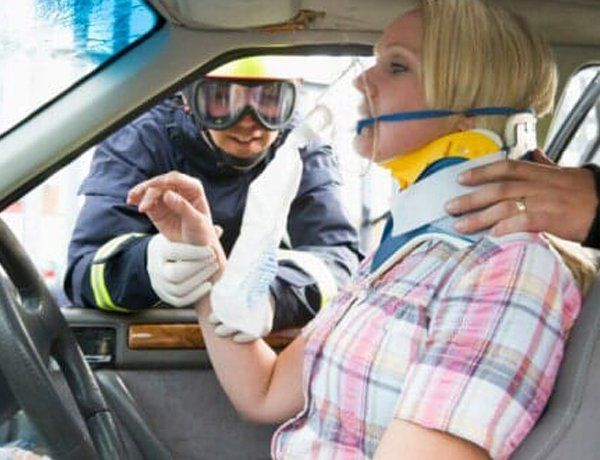Motor Vehicle Injury Treatment at Pain and Disability Institute
Car Accidents
Neck Injuries
External forces imposed upon the neck can vary from an automobile accident, an athletic injury, a fall, to a direct blow. The extent of injury cannot always be immediately determined and the primary care of the injured patient muse be scrupulously observed.
Muscular deceleration and acceleration of the forward flexing r, pine from the erect ligamentous support to the fully flexed ligamentous restriction. Muscle eccentric and concentric contraction permits forward flexion and re-extension. At the scene of an accident it muse be assumed that the neck has been injured and possibly the cord has also been traumatized.
An adequate airway muse be maintained while the patient is still at the place of injury.
Further care of the cervical fracture-dislocation with or without necrologic deficit is beyond the scope of this text and requires the intercedence of a specialist. The precautions listed here are to insure the patient's reaching this specialist without additional damage or injury.
In injuries with no severe impact or symptoms and no necrologic deficit the condition of acute sprain with soft tissue injury muse be assumed to have occurred. An accident need not be severe to cause cervical injury; in face, injury can be sustained from rapid braking of a car, stepping from an unnoticed curb, or stepping into a depression in the ground.
Forceful flexion and/or extension causes damage to the longitudinal ligaments, the intervertebral disk, the areicular capsules, the ligaments, and the muscles of the neck. Simultaneously the spinal canal is acutely narrowed as are the intervertebral foramina. The sensitive tissues of the functional unit are involved, which results in local and referred pain.
Diagnosis and Evaluation - X-Rays and Physical Examination
FIGURE 97. Head and cervical flexion. In head flexion the head is flexed upon the cervical spine with movement only at the occipito-atlas; in neck flexion there is reversal of the cervical lordosis. Most flexion occurs between C4 and C5 or C5 and C6.
Lateral flexion and rotation occur simultaneously when done actively by the patient.
FIGURE 100. Neck flexor trauma from rear-end injury. Hyperextension causes an overstretch and inappropriate contraction of the neck flexors with residual flexor disability.
Treatment of Acute Injury
Because an acute injury may cause soft tissue inflammation with undoubted microscopic tissue damage, these tissues muse be placed at rest in a physiologic position. A muscle spasm follows an acute injury to protect the injured pare by immobilization, but this spasm, as well as being beneficial, may also be detrimental. Therefore, proper immobilization of the neck is mandatory but presents problems.
Immobilization of the neck requires prevention of motion of the occipito-cervical junction and of the cervical column from the second to seventh vertebra. Rotation and lateral flexion muse also be restricted. Immobilization with a cervical collar is indicated.
Collar and Brace
Plastic collars are made more Hoff felt collars by including metal strips that adjust the height of the collar. It is estimated this collar restricts flexion and extension by 75 percent but restricts rotation by only 50 percent.
FIGURE 101. Felt collar recommended for occipito-cervical restriction.
The four-poster cervical brace is cumbersome to maintain and difficult to adjust. It restricts approximately the same degree of flexion-extension as does the plastic collar but permits rotation of the atlaneoaxial joint.
No collar or brace has proven to fully immobilize the neck in all directions. Only a Halo body jacket brace will fully immobilize the neck in flexion-extension, rotation, and lateral bending, and this is regarded only in severe orthopedic or neurologic problems.
Exercises
Exercises should be considered very early in the care of hyperextension injuries-of-significance intensity of the cervical spine.
Physical Therapy
Modalities such as heat, ice, ultrasound, and infrared have their advocates, but usually ice early and heat in later stages of recovery are preferred. Massage of the painful, Bender, and endurated muscles is of value preceding gentle gradual exercises.
Traction
Traction also has equivocal support but has clinical value when properly applied.
Traction with neck in slight flexion will decrease the lordosis and open the intervertebral foramina and separate the posterior articulations.
Traction can also be applied manually which can be combined with lateral and rotatory screech to increase range of motion.
FIGURE 101. Felt collar recommended for occipito-cervical restriction.
FIGURE 104. Ineffective home door cervical traction. The patient is too close to the door to get the corred neck flexion angle.
The door freely opens and closes, not permitting constant traction. The patient cannot extend the legs or assume a comfortable position. This type of home traction is not recommended.
FIGURE 105. Recommended home traction from chinning bar in sitting position.
After subsidence of acute symptomatology by the use of a collar, concomitant exercises and daily traction posture and modification of daily activities must be undertaken. The collar should never be used for prolonged periods nor be used without appropriate exercises.
Burns:
Tissue injury caused by thermal, radiation, chemical, or electrical contact resulting in protein denaturation, burn wound edema, and loss of intravascular fluid volume due to increased vascular permeability.







